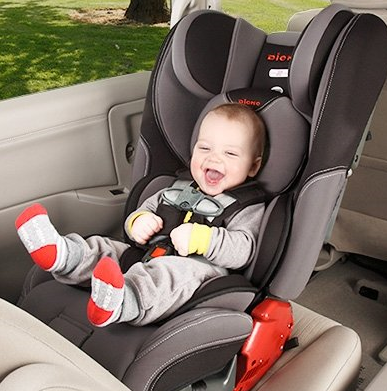Why can’t kids just wear a seat belt?
Vehicle seats and seat belts are designed for adult-size bodies that are at least 4’9” tall. A child can slip out from under a lap-only belt and be ejected. Their body may also fold in half (like a tube of toothpaste) during a crash. There is even a medical name for this, Seat Belt Syndrome. In a severe crash, lap belts have been shown to cause serious injury to the liver, spleen, and intestines. In some cases, the spinal cord can be damaged and the child can become paralyzed.

A lap/shoulder belt isn’t the answer either. On young children, the lap belt tends to ride up over the soft abdomen, or tummy, and the shoulder belt may cross the neck or face. The solution is NOT to place the shoulder belt behind the child’s back, or under the arm. The child then has no upper body protection and can suffer broken ribs and injuries to internal organs. With no upper body protection, there is also great potential for head injury. This is a very serious concern as the brain is the organ least likely to recover from injury.
How does a booster seat work?
A booster seat helps raise a child up so that the adult lap and shoulder belt fit properly; the lap belt should be across the top of the thighs, and the shoulder belt should fit across the center of the child’s shoulder and chest.
What types of booster seats are available?
There are two basic types. A high-back booster seat has a back that protects a child against whiplash in cars with low vehicle seat backs/no headrests. No-back boosters (also known as backless boosters) are appropriate for vehicle seats that have a high back and head rest. Both types of seats are effective in protecting children in car crashes.
How effective are booster seats?
Booster seats are extremely effective in preventing injuries in a crash. A child is 59 percent safer in a booster seat than a seat belt alone. A booster is 4 times more effective in preventing a head injury than a seat belt alone.
Are booster seats readily available?
Booster seats are widely available at stores such as Target, Kmart, Toys R Us, and Meijer. They are also available on the Internet. Booster seats are very affordable. Backless booster seats can be purchased for as low as $15.00. That’s the price of two adult movie tickets or a large pizza! High-back boosters can be purchased for as low as $30.00. Furthermore, there are many car seats available that convert from a toddler seat to a booster seat so no additional seat needs to be purchased.
What happens when a parent carpools or another person picks up the kids?
This is no different than any other parenting issue. The safety of the child is the first consideration. The laws of physics in a crash still apply if the person is picking up the child only once or going a short distance. Booster seats are very important in keeping a child safe. Since a booster seat is small and relatively light, it can transfer easily between one vehicle to another. Booster seats are inexpensive so having a booster in both vehicles should not be a huge monetary consideration or hardship. As mentioned previously, the price of a booster is equivalent to the price of two adult movie tickets or a large pizza.
What if we pass a law and a family can’t afford a booster seat?
There are many opportunities for Michigan families in need. Many child safety seat fitting stations will be able to supply a booster seat and many other organizations have large quantities of booster seats for families. A complete list is being developed.
What are other states doing?
Many states are making their child passenger safety laws more comprehensive. All children should be appropriately covered. As of January 2007, 38 states and the District of Columbia had passed booster seat laws. Included in this list are our neighbors, Indiana and Illinois.
When can a child ride in an adult seat belt?
A child can ride safely in a seat belt when it fits right, typically when the child is at least 4’9” tall and 8 years old.
The seat belt fits correctly when: